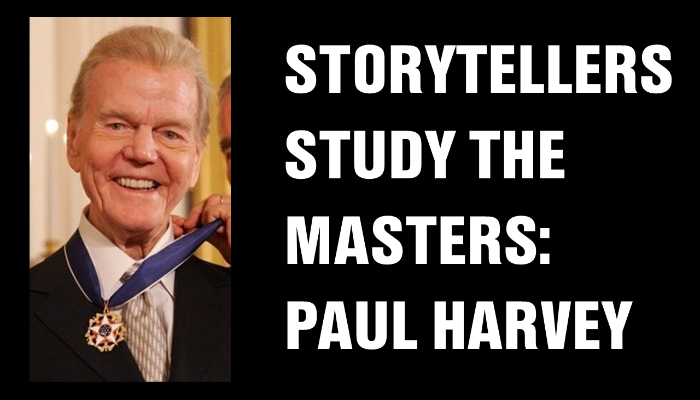
Paul Harvey’s voice filled the radio waves for over fifty years. He’s most famous for a show called, The Rest of the Story, where he’d tell a story of a famous person or event, being careful to obscure details that might identify either. The audience would listen in anticipation, knowing that Harvey was setting them up to reveal some delightful secret that tied everything together. He’d then finish each episode with his signature, “Now you know the rest of the story.”
The best way to understand The Rest of the Story is to listen to one.
While it’s always better to listen to Paul deliver The Rest of The Story, here’s a transcript of this episode:
Now, the rest of the story.
Remember these four words. Al was utterly useless. Al was utterly useless.
“I’m nothing but a burden on my family,” he once told his sister in a letter. “Really, it would have been better if I had never been born.”
Al had hit bottom by the age of twenty-two. His parents, impoverished, were no longer able to support him. He needed a job but nobody would hire him. In desperation, Al appealed to an old school friend–a fellow whose class notes he used to copy. The friend’s father had government connections. And a few days later, Al was being interviewed for a position at the Federal Patent Office.
Fred Haller was then director of the agency. He would conduct the interview personally. Haller informed the young man that he needed personnel capable of judging whether a request for a patent had any justification.
“What do you know about patents?” the director asked, and Al replied, “Nothing. Nothing at all.”
The director blinked a couple of times–ordinarily he would have terminated the interview then and there, and yet, there was something intriguing in the young man’s frankness.
“Tell me a bit about yourself,” the director asked, and Al forced a smile. What was there to tell? He’d been thrown out of high school at fifteen. With no high school diploma, college was out of the question. So he applied at a technical school, but then he flunked his first entrance exam. So he went back to high school–a different high school–actually because his old high school refused to readmit him.
Now this time he graduated. He was even accepted thereafter at Technical School. But when prospective employers subsequently discovered that he had cut classes chronically and that he had passed exams only narrowly, and had treated professors irreverently, well…nobody would hire him.
Nobody would hire him! And now here he was in the Federal Patent Office asking for a job for which he was not qualified. What kind of a loser could summon up that kind of nerve? But Director Haller was not so certain. Yes, he had heard all of the reasons why he should not hire Al. But what he wanted to hear now were all of the reasons why he should.
You know what? That interview continued for almost two hours and by the time it was over, the director had come to this conclusion: Al was not stupid. He was simply a failure. If he were ever to stop failing and make something of himself, he would first require a large dose of self-confidence.
So Director Haller decided to give Al a break–a probationary job as Technical Expert, 3rd Class.
You see, though, property’s impression of Al is larger than life. He was not destined to guide lesser minds through space and time. In fact at twenty-two, he stood at the brink of utter obscurity. And then he got that job at the Swiss Federal Patent Office. And inspired by his very first unequivocal success, he eventually learned to live up to his best–his very best–and to become the groundbreaking genius the world now knows as Albert Einstein.
Only now, you know, the rest of the story.
Storytellers study the masters. So let’s look at the mechanics of The Rest of the Story.
The Rest of the Story is constructed as a story within a story. This inside-out storytelling technique delivers an outer story that the listener likely knows, through an inner story that keeps the listener from connecting the dots.
The outer story is based on the general knowledge that Albert Einstein was one of the smartest humans to walk the earth. The inner story reveals just enough hints to the outer story, but not enough for the audience to make a direct connection. For example, in the inner story, Harvey chose to call the character Al as opposed to Albert. He then deepened his deception by delivering facts not typically associated with a genius, such as a drop-out loser who couldn’t hold onto a job.
The inside-out story structure holds much value for business storytellers.
| Lesson | Description |
|---|---|
| Stories can be short | The stories found in The Rest of the Story were always under four minutes long. This example story contains only 543 words. |
| Stories are everlasting | The fact that Paul Harvey’s show ran for a half century proves that stories can cross generations. Consider that this story of Albert Einstein is still relevant to today’s modern audiences. |
| Stories can have a business model | The Rest of the Story was always broken into two pieces: the setup and the finale with Harvey reading advertising copy in between. Unlike today’s link bait, Harvey’s listeners knew that a valuable payoff awaited them on the other side of the commercial. Had he disappointed them, the show would never have enjoyed such longevity. |
I grew up listening to Paul Harvey. His influence on my own storytelling is indisputable. He taught me the inside-out technique of embedding a story within a story.
Now it’s your turn. Go turn something inside-out.
Recording Credit: archive.org
Photo Credit: Wikipedia/Wikimedia Commons/Public Domain Paul Harvey